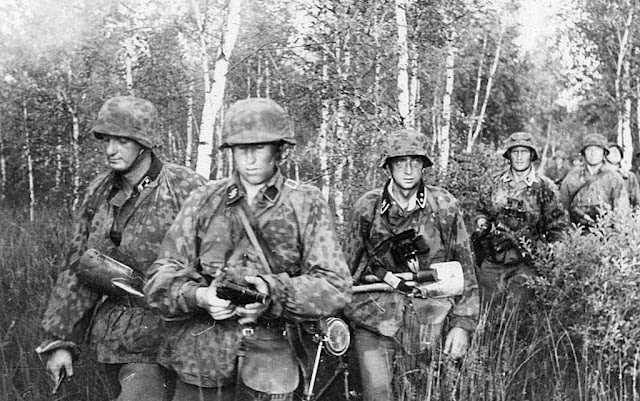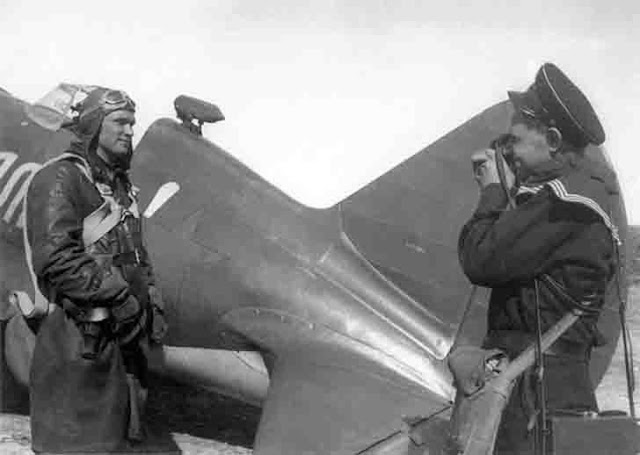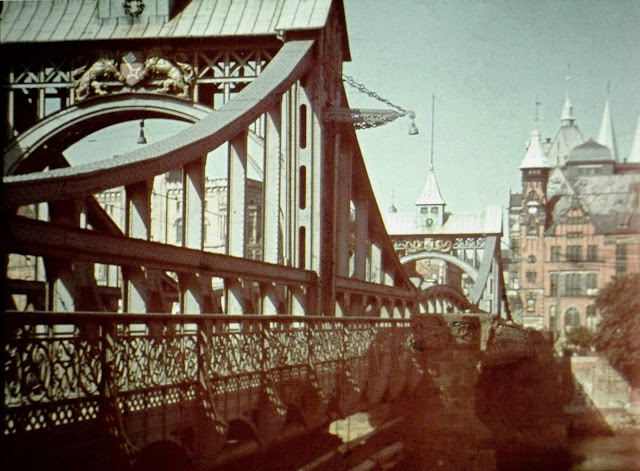Saturday 9 August 1941
 |
| HMS Prince of Wales arrives at Placentia Bay, Newfoundland, 9 August 1941. In the background are ships of the US Navy, one of which carries President Franklin D. Roosevelt. (© IWM (A 4826)). |
Eastern Front: In the Army Group North sector, German 16th Army begins an offensive on 9 August 1941 toward Kingisepp and Novgorod at the northern tip of Lake Ilmen. German troops already are in Staraya Russa to the south of Lake Ilmen, taking Novgorod would enable the Germans to use the lake as part of the German line. The 21st Infantry Division (General Sponheimer), reinforced by 424th Infantry Regiment of 126th Infantry Division, attacks east along the main road. The offensive advances five miles by nightfall in a very rough and well-fortified area.
In the Army Group Center sector, the Soviets continue attacking the German "lightning rod" position at Yelnya. The Germans repulse the attacks after hard fighting.
In the Army Group South sector, the Uman pocket now has surrendered and the 100,000 prisoners are being processed prior to being sent to POW camps. Pursuant to orders, General von Kleist is driving north toward Kyiv in order to effect a junction with General Guderian's Panzer Group 2. While this makes some sense from an operational viewpoint because the possibility exists of surrounding a large force of Soviet troops, it also alters the initial Army Group South goal of heading south and taking the Crimea, an important objective in Hitler's view. The Stavka takes advantage of this new diversion and begins reinforcing the neck of the Crimea with the 9th Coastal Army (independent) and remnants of other battered armies.
Romanian 4th Army makes some small gains in Ukraine, capturing the villages of Ponyatovka and Razdelnaya, while the German 11th and 17th Armies attack along the Southern Bug River. German 6th Army continues pressing forward in the Kyiv area.
European Air Operations: The RAF has a light schedule today. Its only mission is a Circus Operation with five Blenheim bombers against the Gosnay power station. The bombers get lost or are deterred by fighter opposition and bomb Gravelines instead. All return to base.
During this mission, RAF Wing Commander Douglas Bader in his Spitfire Mk VA shoots down a Bf 109 and maybe a second when apparently his plane is hit by either friendly or enemy fire (Bader himself thinks it is a mid-air collision, but other records indicate this is unlikely). Bader successfully parachutes out after losing his right prosthetic leg which becomes ensnared in the falling aircraft (it is later found in an open field but is too damaged to use again). No German pilot is awarded the victory, suggesting strongly that it may have been friendly fire, and there is some other inconclusive evidence to support that theory.
Bader has 22 aerial victories, four shared victories, six probable victories, one shared probable victory, and 11 enemy aircraft damaged.
The Germans treat Bader with great respect, as they are well aware of RAF propaganda heroes. JG 26 commander Adolf Galland has lunch with Bader but refuses Bader's request to "try out" a Bf 109, explaining, "It would pain me to have to chase you and shoot you down." The Germans are a little too respectful, it turns out, as Bader attempts to escape from his hospital but is quickly recaptured.
Hermann Goering, a former fighter pilot himself, personally authorizes the RAF to air-drop a replacement artificial leg for Bader at St. Omer airfield in the "Leg Operation" on 19 August. Galland later recalls that the British also drop bombs on the Luftwaffe airport in addition to the replacement leg.
Battle of the Baltic: Soviet submarine SC-307 (Treska), commanded by N. I. Petrov, torpedoes and sinks U-144 (Kptlt. Gert von Mittelstaedt), on its third patrol out of Stormelö, near the Estonian island of Hiiumaa (Dagö). All 28 men on U-144 perish. This is revenge for U-144 sinking 206-ton Soviet submarine M-78 on 23 June 1941, the only victory claimed by U-144.
Soviet auxiliary minesweeper T-487 sinks today from unknown causes.
German 210-ton freighter Gertrude III hits a mine and sinks off Windau/Ventspils, Latvia.
Battle of the Atlantic: The Germans continue their aggressive patrols in the far north at the Kola Inlet, sending a destroyer force (Hans Lody, Freidrich Eckholdt, and Richard Beitzen) that sinks Soviet patrol ship SKR.12. The Soviets, as they have done elsewhere when the Germans begin operations in a new area, have reinforced the area and now are able to fight back. They furiously attack the German ships with artillery and air attacks and force them to withdraw. Destroyer Richard Beitzen is damaged by near misses but makes it back to port with the other ships.
Royal Navy destroyer HMS Croome rams and sinks Italian submarine Maggiore Baracca northeast of the Azores.
Some sources state that U-206 (ObltzS Herbert Opitz), on its first patrol out of Trondheim, sinks 202-ton British fishing trawler Ocean Victor today. Other sources claim that Ocean Victor is sunk by the Luftwaffe. In any event, Ocean Victor sinks southeast of Iceland roughly halfway between Iceland and the Faroe Islands.
The Luftwaffe bombs and sinks 2345-ton British freighter Cordene, which is traveling in Convoy FN-503 a few miles east of Cromer in the North Sea. Escorting destroyer HMS Electra, on its first escort mission after a refit, picks up the entire crew and takes them to Scapa Flow.
The Luftwaffe bombs and sinks Norwegian 1392-ton freighter Dagny about 20 km east of the southern Faroe Islands. Dagny is in tow of trawler Leicester City when it is attacked. There are two deaths, the rest of the remaining 61 crew and passengers on board are picked up by the trawler.
The Luftwaffe bombs and damages 868-ton British freighter Glendalough near where the Cordene is sunk off Cromer. Another ship tows Glendalough to Yarmouth Roads for emergency repairs, then to Hull for permanent repairs.
Royal Navy gunboat MGB.62 collides with the gunboat MGB-67, in the North Sea and sinks.
Norwegian submarine B.1 has an explosion in her engine room caused by her battery at Blyth. The explosion sets off some ammunition, causing extensive damage. The submarine is already under repair and this just adds to its time in the shipyard.
A commercial flight between London and Lisbon spots an unidentified freighter west of La Rochelle. The Royal Navy sends multiple ships out to investigate from Gibraltar and passing convoys, but none finds the ship.
Royal Navy submarine HMS Severn spots a submarine, apparently Italian, several hundred miles west of Tangier in the Atlantic. The Italian submarine apparently notices it is being watched because it immediately submerges. Neither submarine launches an attack.
Convoy HG-70 departs from Gibraltar bound for Liverpool.
Royal Navy corvette HMS Cowslip (Lt. Frederick Granger) is commissioned, minesweeping trawler Shiant is launched.
U-267 and U-360 are laid down.
Battle of the Mediterranean: Royal Navy destroyers HMS Jervis and Kingston make a supply run from Alexandria to Mersa Matruh, while destroyers Decoy and Havock make a supply run from Alexandria to Tobruk.
At Malta, an RAF No. 69 Maryland on patrol over Sicily drops a few bombs in August, damaging some buildings.
US Secretary of State Cordell Hull gives a memorandum to Lord Halifax, the British Ambassador. It provides that Hull will confer with his counterpart in England (currently Anthony Eden) in the case of further Japanese military movements to the south (apparently meaning beyond French Indochina).
Finnish/Swedish Relations: A battalion of Swedish volunteers under Finnish command is ordered into the line in southern Finland facing the Soviet enclave of Hango.
British Military: King George VI arrives at Scapa Flow for an inspection.
Japanese Military: The Imperial Japanese Navy requisitions 8606-ton freighter Kanto Maru and begins converting it into an armed auxiliary aircraft transport. The military version receives 120-mm (4.7-inch) guns at the bow and the stern.
The Imperial General Headquarters staff once again approves a strategy of attacking south toward the oil fields in Indonesia rather than attacking north into the USSR. Attacking the Soviet Union remains under consideration. However, the high command makes a firm decision to do nothing in that regard before the spring of 1942.
Holocaust: Germans execute 534 Jews in Kaunas.
American Homefront: Charles Lindbergh, a prominent figure in the America First anti-war movement, makes a speech in Cleveland that is broadcast over the radio. He warns of interventionists planning "incidents and situations" that will lead the US intentionally into war "under the guise of defending America."
Warner Bros. releases "Manpower," directed by Raoul Walsh and starring Edward G. Robinson, Marlene Dietrich, and George Raft. The film received a lot of publicity during filming due to a reported fistfight on the set between Raft and Robinson, reportedly due to Raft's resentment at Robinson's late hiring which made Robinson the headliner instead of Raft (this may all be studio fakery, though, because it rather suspiciously mirrors a film plot point). Raft turned down "The Maltese Falcon" to make "Manpower," a pretty poor career decision, as "Falcon" made Humphrey Bogart a major film star after years of being just a character actor. "Manpower" goes on to become a box office hit, though it gets mixed reviews and never achieves the rank of a true classic in most filmgoers' eyes.
The Looney Tunes cartoon "We, the Animals Squeak" is released on 9 August 1941. It is a colorized Looney Tunes cartoon starring Porky Pig. The cartoon is directed by Bob Clampett. The voices are performed by Mel Blanc, Sara Berner, Billy Bletcher and Michael Maltese. This is one of the Porgy Pig cartoons that is colorized. "We, the Animals Squeak" is a parody of the 1930s radio program, "We the People," an early reality program where people would share unusual stories with the audience. Porky Pig is the program's moderator.
August 1941
August 1, 1941: More Executions on Crete
August 2, 1941: Uman Encirclement Closes
August 3, 1941: Bishop von Galen Denounces Euthanasia
August 4, 1941: Hitler at the Front
August 5, 1941: Soviets Surrender at Smolensk
August 6, 1941: U-Boats in the Arctic
August 7, 1941: Soviets Bomb Berlin
August 8, 1941: Uman Pocket Captured
August 9, 1941: Atlantic Conference at Placentia Bay
August 10, 1941: Soviet Bombers Mauled Over Berlin
August 11, 1941: Rita Hayworth in Life
August 12, 1941: Atlantic Charter Announced
August 13, 1941: The Soybean Car
August 14, 1941: The Anders Army Formed
August 15, 1941: Himmler at Minsk
August 16, 1941: Stalin's Order No. 270
August 17, 1941: Germans in Novgorod
August 18, 1941: Lili Marleen
August 19, 1941: Convoy OG-71 Destruction
August 20, 1941: Siege of Leningrad Begins
August 21, 1941: Stalin Enraged
August 22, 1941: Germans Take Cherkassy
August 23, 1941: Go to Kiev
August 24, 1941: Finns Surround Viipuri
August 25, 1941: Iran Invaded
August 26, 1941: The Bridge Over the Desna
August 27, 1941: Soviets Evacuate Tallinn
August 28, 1941: Evacuating Soviets Savaged
August 29, 1941: Finns take Viipuri
August 30, 1941: Operation Acid
August 31, 1941: Mannerheim Says No
2020
In the Army Group Center sector, the Soviets continue attacking the German "lightning rod" position at Yelnya. The Germans repulse the attacks after hard fighting.
In the Army Group South sector, the Uman pocket now has surrendered and the 100,000 prisoners are being processed prior to being sent to POW camps. Pursuant to orders, General von Kleist is driving north toward Kyiv in order to effect a junction with General Guderian's Panzer Group 2. While this makes some sense from an operational viewpoint because the possibility exists of surrounding a large force of Soviet troops, it also alters the initial Army Group South goal of heading south and taking the Crimea, an important objective in Hitler's view. The Stavka takes advantage of this new diversion and begins reinforcing the neck of the Crimea with the 9th Coastal Army (independent) and remnants of other battered armies.
Romanian 4th Army makes some small gains in Ukraine, capturing the villages of Ponyatovka and Razdelnaya, while the German 11th and 17th Armies attack along the Southern Bug River. German 6th Army continues pressing forward in the Kyiv area.
 |
| Flak gun at the Bug River in the Soviet Union, 9 August 1941. (Federal Archive, B 145 Bild-F016203-15). |
During this mission, RAF Wing Commander Douglas Bader in his Spitfire Mk VA shoots down a Bf 109 and maybe a second when apparently his plane is hit by either friendly or enemy fire (Bader himself thinks it is a mid-air collision, but other records indicate this is unlikely). Bader successfully parachutes out after losing his right prosthetic leg which becomes ensnared in the falling aircraft (it is later found in an open field but is too damaged to use again). No German pilot is awarded the victory, suggesting strongly that it may have been friendly fire, and there is some other inconclusive evidence to support that theory.
Bader has 22 aerial victories, four shared victories, six probable victories, one shared probable victory, and 11 enemy aircraft damaged.
The Germans treat Bader with great respect, as they are well aware of RAF propaganda heroes. JG 26 commander Adolf Galland has lunch with Bader but refuses Bader's request to "try out" a Bf 109, explaining, "It would pain me to have to chase you and shoot you down." The Germans are a little too respectful, it turns out, as Bader attempts to escape from his hospital but is quickly recaptured.
Hermann Goering, a former fighter pilot himself, personally authorizes the RAF to air-drop a replacement artificial leg for Bader at St. Omer airfield in the "Leg Operation" on 19 August. Galland later recalls that the British also drop bombs on the Luftwaffe airport in addition to the replacement leg.
 |
| Oberstleutnant Hans von Ahlfen confers with officers about a bridge being built across the Bug River as part of the German advance, 9 August 1941 (Federal Archive, B 145 Bild-F016203-19). |
Soviet auxiliary minesweeper T-487 sinks today from unknown causes.
German 210-ton freighter Gertrude III hits a mine and sinks off Windau/Ventspils, Latvia.
 |
| President Roosevelt and Prime Minister Churchill at Placentia Bay, 9 August 1941. |
Battle of the Atlantic: The Germans continue their aggressive patrols in the far north at the Kola Inlet, sending a destroyer force (Hans Lody, Freidrich Eckholdt, and Richard Beitzen) that sinks Soviet patrol ship SKR.12. The Soviets, as they have done elsewhere when the Germans begin operations in a new area, have reinforced the area and now are able to fight back. They furiously attack the German ships with artillery and air attacks and force them to withdraw. Destroyer Richard Beitzen is damaged by near misses but makes it back to port with the other ships.
Royal Navy destroyer HMS Croome rams and sinks Italian submarine Maggiore Baracca northeast of the Azores.
Some sources state that U-206 (ObltzS Herbert Opitz), on its first patrol out of Trondheim, sinks 202-ton British fishing trawler Ocean Victor today. Other sources claim that Ocean Victor is sunk by the Luftwaffe. In any event, Ocean Victor sinks southeast of Iceland roughly halfway between Iceland and the Faroe Islands.
The Luftwaffe bombs and sinks Norwegian 1392-ton freighter Dagny about 20 km east of the southern Faroe Islands. Dagny is in tow of trawler Leicester City when it is attacked. There are two deaths, the rest of the remaining 61 crew and passengers on board are picked up by the trawler.
The Luftwaffe bombs and damages 868-ton British freighter Glendalough near where the Cordene is sunk off Cromer. Another ship tows Glendalough to Yarmouth Roads for emergency repairs, then to Hull for permanent repairs.
Royal Navy gunboat MGB.62 collides with the gunboat MGB-67, in the North Sea and sinks.
 |
| Churchill and Roosevelt aboard USS Augusta, 9 August 1941. Roosevelt, wearing a naval uniform, likes to call himself "former naval person" in his regular cables to Roosevelt. |
A commercial flight between London and Lisbon spots an unidentified freighter west of La Rochelle. The Royal Navy sends multiple ships out to investigate from Gibraltar and passing convoys, but none finds the ship.
Royal Navy submarine HMS Severn spots a submarine, apparently Italian, several hundred miles west of Tangier in the Atlantic. The Italian submarine apparently notices it is being watched because it immediately submerges. Neither submarine launches an attack.
Convoy HG-70 departs from Gibraltar bound for Liverpool.
Royal Navy corvette HMS Cowslip (Lt. Frederick Granger) is commissioned, minesweeping trawler Shiant is launched.
U-267 and U-360 are laid down.
 |
| Star Weekly magazine, August 9, 1941. Star Weekly is a publication of the Toronto Star. |
At Malta, an RAF No. 69 Maryland on patrol over Sicily drops a few bombs in August, damaging some buildings.
Air Marshal Arthur Coningham arrives in Egypt from London and takes command of RAF No. 204 Group in North Africa.
 |
| Earl Oliver Hurst, "Cream Puff Sailor," Collier's, August 9, 1941. |
Anglo/US Relations: Royal Navy battleship HMS Prince of Wales arrives in Placentia Bay carrying British Prime Minister Winston Churchill to the Atlantic Conference (codenamed Riviera). President Roosevelt has been waiting there for Churchill aboard heavy cruiser USS Augusta for a couple of days idling his time by fishing off the forecastle. The two men quickly get down to business. Meeting on Augusta over lunch and dinner, Churchill and Roosevelt hammer out any remaining issues concerning the Atlantic Charter which the two men intend to sign during the four-day conference. After dinner, Churchill returns to Prince of Wales. The top military staff of the US and the UK get to know each other in a similar fashion.
US Secretary of State Cordell Hull gives a memorandum to Lord Halifax, the British Ambassador. It provides that Hull will confer with his counterpart in England (currently Anthony Eden) in the case of further Japanese military movements to the south (apparently meaning beyond French Indochina).
Finnish/Swedish Relations: A battalion of Swedish volunteers under Finnish command is ordered into the line in southern Finland facing the Soviet enclave of Hango.
British Military: King George VI arrives at Scapa Flow for an inspection.
 |
| The New Yorker, August 9, 1941. |
The Imperial General Headquarters staff once again approves a strategy of attacking south toward the oil fields in Indonesia rather than attacking north into the USSR. Attacking the Soviet Union remains under consideration. However, the high command makes a firm decision to do nothing in that regard before the spring of 1942.
Holocaust: Germans execute 534 Jews in Kaunas.
American Homefront: Charles Lindbergh, a prominent figure in the America First anti-war movement, makes a speech in Cleveland that is broadcast over the radio. He warns of interventionists planning "incidents and situations" that will lead the US intentionally into war "under the guise of defending America."
Warner Bros. releases "Manpower," directed by Raoul Walsh and starring Edward G. Robinson, Marlene Dietrich, and George Raft. The film received a lot of publicity during filming due to a reported fistfight on the set between Raft and Robinson, reportedly due to Raft's resentment at Robinson's late hiring which made Robinson the headliner instead of Raft (this may all be studio fakery, though, because it rather suspiciously mirrors a film plot point). Raft turned down "The Maltese Falcon" to make "Manpower," a pretty poor career decision, as "Falcon" made Humphrey Bogart a major film star after years of being just a character actor. "Manpower" goes on to become a box office hit, though it gets mixed reviews and never achieves the rank of a true classic in most filmgoers' eyes.
 |
| Saturday Evening Post, August 9, 1941, "Dunked Under Water." |
August 1941
August 2, 1941: Uman Encirclement Closes
August 3, 1941: Bishop von Galen Denounces Euthanasia
August 4, 1941: Hitler at the Front
August 5, 1941: Soviets Surrender at Smolensk
August 6, 1941: U-Boats in the Arctic
August 7, 1941: Soviets Bomb Berlin
August 8, 1941: Uman Pocket Captured
August 9, 1941: Atlantic Conference at Placentia Bay
August 10, 1941: Soviet Bombers Mauled Over Berlin
August 11, 1941: Rita Hayworth in Life
August 12, 1941: Atlantic Charter Announced
August 13, 1941: The Soybean Car
August 14, 1941: The Anders Army Formed
August 15, 1941: Himmler at Minsk
August 16, 1941: Stalin's Order No. 270
August 17, 1941: Germans in Novgorod
August 18, 1941: Lili Marleen
August 19, 1941: Convoy OG-71 Destruction
August 20, 1941: Siege of Leningrad Begins
August 21, 1941: Stalin Enraged
August 22, 1941: Germans Take Cherkassy
August 23, 1941: Go to Kiev
August 24, 1941: Finns Surround Viipuri
August 25, 1941: Iran Invaded
August 26, 1941: The Bridge Over the Desna
August 27, 1941: Soviets Evacuate Tallinn
August 28, 1941: Evacuating Soviets Savaged
August 29, 1941: Finns take Viipuri
August 30, 1941: Operation Acid
August 31, 1941: Mannerheim Says No
2020




























